
Recently, the International Union of Pure and Applied Chemistry (IUPAC) announced the top ten emerging chemical technologies for 2024, and the triboelectric nanogenerator (TENG) technology invented by Academician Zhonglin Wang and his team from the Beijing Institute of Nanoenergy and Nanosystems, Chinese Academy of Sciences, was selected. The related research by Academician Wang’s team, titled “Advances in Triboelectric Nanogenerators for Blue Energy Harvesting and Marine Environmental Monitoring,” was published in the February 2024 issue of the journal Engineering. This study introduces the theoretical basis of triboelectric nanogenerators, including their fundamental physical mechanisms and basic working modes, as well as the original idea of utilizing a network of triboelectric nanogenerators to harvest large-scale blue energy. Jiang Yang and Liang Qian are the first authors of the article, while Jiang Tao and Zhonglin Wang are the corresponding authors.
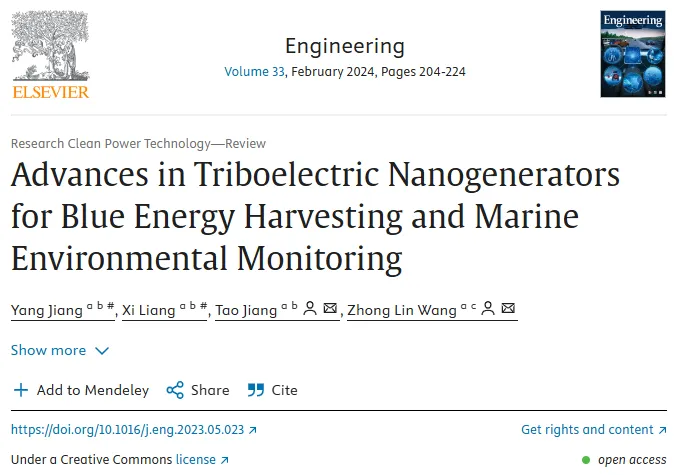
The ocean contains rich blue energy resources, such as tidal energy, wave energy, and water flow energy, making it a highly promising renewable resource. However, existing technologies face many limitations in their development and utilization, leading to low utilization rates. Electromagnetic generators (EMG) are currently the main method for energy harvesting, but they have issues such as high costs, difficult installation, susceptibility to erosion, low efficiency, and poor stability. Against this backdrop, triboelectric nanogenerators and their networks have emerged as a new method for blue energy harvesting, bringing new hope for the development and utilization of blue energy.
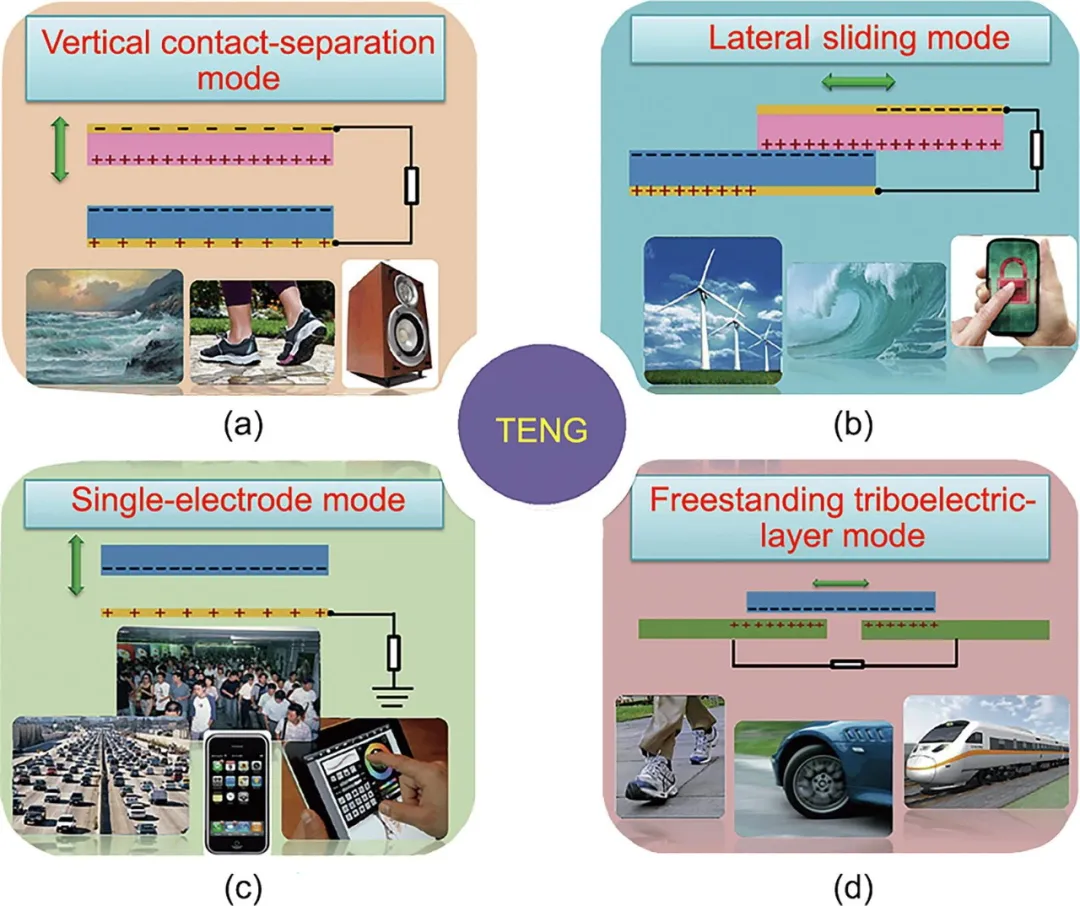
Figure 1. Four basic modes of TENG: (a) vertical contact-separation mode; (b) horizontal sliding mode; (c) single-electrode mode; (d) independent triboelectric layer mode.
The triboelectric nanogenerator was first proposed by Academician Zhonglin Wang in 2012, based on the coupling effect of contact electrification (CE) and electrostatic induction, generating electricity through the contact-separation between two different materials. Its output is derived from Maxwell’s displacement current. The triboelectric nanogenerator collects energy from human motion, vibrations, mechanical triggers, wind, and water flow, and is categorized into four basic working modes: vertical contact-separation mode, horizontal sliding mode, single-electrode mode, and independent triboelectric layer mode. Based on these modes, triboelectric nanogenerators can successfully harvest energy from surface waves, water surface waves, and the impact of water on coasts. In 2014, Academician Wang proposed the idea of harvesting large-scale ocean blue energy using a network of three-dimensional triboelectric nanogenerators due to the low and disordered frequency of water energy.
Researchers have designed a series of advanced triboelectric nanogenerator prototypes to improve the efficiency and durability of blue energy harvesting. These prototypes include spherical triboelectric nanogenerators, cylindrical triboelectric nanogenerators, swinging structure triboelectric nanogenerators, three-dimensional electrode triboelectric nanogenerators, and spring-assisted structures, mass-spring structures, multilayer structures, and pendulum structures for the contact-separation mode triboelectric nanogenerators. For example, the spherical structure triboelectric nanogenerator is simple to operate and sensitive to small waves; the cylindrical triboelectric nanogenerator has high wear resistance and durability; the swinging structure triboelectric nanogenerator can collect ultra-low frequency water wave energy; and the three-dimensional electrode structure greatly increases the contact interface, enhancing charge and power output.
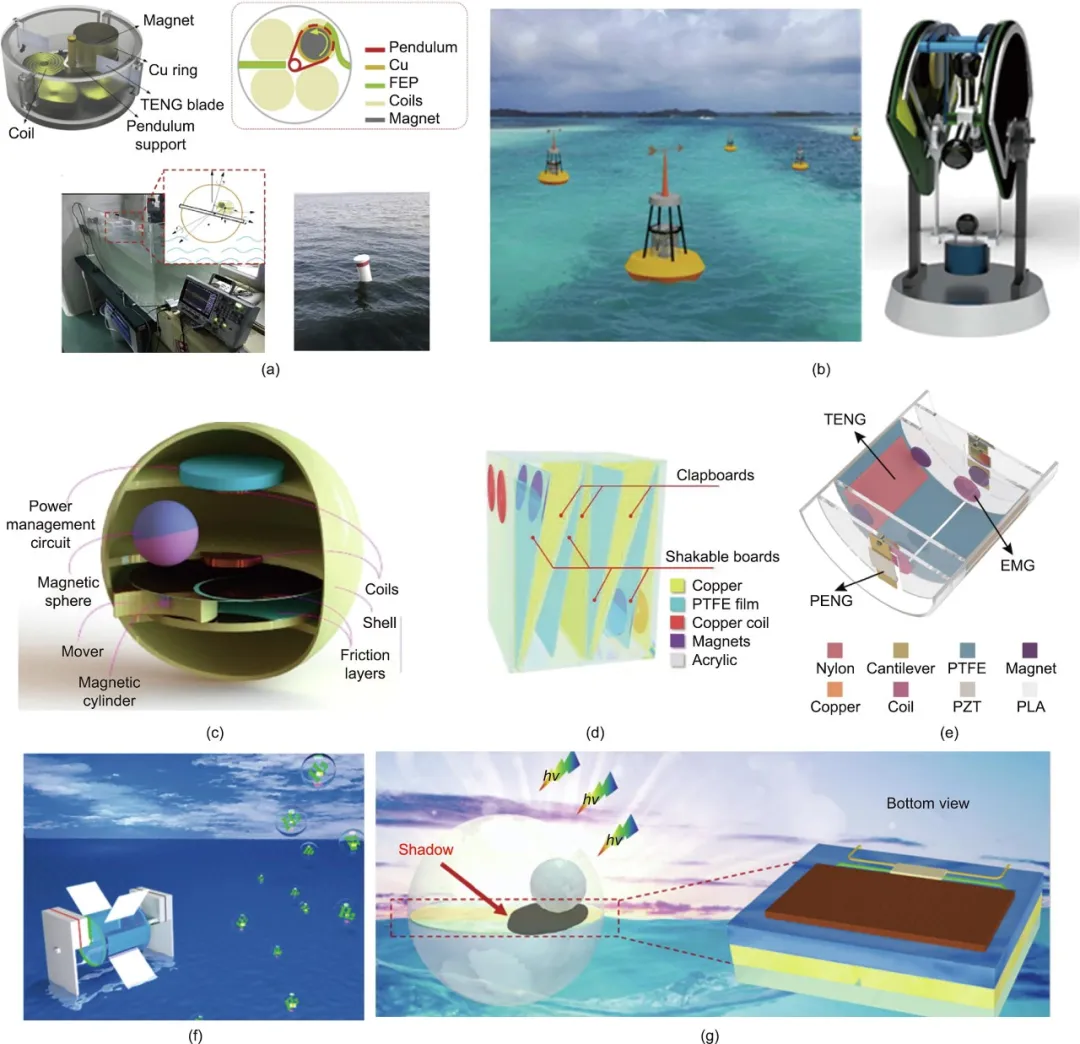
Figure 2. (a) Rotating pendulum triboelectric-electromagnetic hybrid generator; (b) chaotic pendulum triboelectric-electromagnetic nanogenerator for wave energy harvesting; (c) spherical triboelectric-electromagnetic wave energy collector; (d) hybrid collector based on pivot hinge design; (e) triboelectric-electromagnetic piezoelectric hybrid nanogenerator; (f) schematic diagram of TENG device for simultaneous harvesting of wind and wave energy; (g) shadow-triboelectric effect nanogenerator with mixed triboelectric effect and shadow effect. PZT: Lead Zirconate Titanate piezoelectric ceramics; PLA: Polylactic Acid.
To further enhance the performance of triboelectric nanogenerators, researchers have explored a series of performance enhancement strategies from material and structural optimization, hybrid energy harvesting, network design, power management, and charge excitation. In terms of material and structural optimization, materials with significant differences in electronegativity are selected, and surface modification of materials is performed through microfabrication or chemical methods, while reasonably designing the structure; in hybrid energy harvesting, triboelectric nanogenerators are combined with other energy harvesting methods such as electromagnetic generators and piezoelectric nanogenerators (PENG); in network design, one-dimensional (1D) chain structures and two-dimensional (2D) planar structure networks are established, and the connection modes between units in the network are explored; in power management, effective power management schemes are developed to convert the alternating pulse electrical energy generated by triboelectric nanogenerators into direct current output; in charge excitation, charge pump and charge excitation schemes are applied to improve the output performance of triboelectric nanogenerators.
The article also introduces the broad applications of triboelectric nanogenerators based on blue energy harvesting in marine environmental monitoring. They can power distributed sensors and signal transmission systems in the ocean for monitoring water temperature, atmospheric pressure, humidity, water quality, wireless SOS alarm systems, integrated marine information detection/signal transmission/display systems, and marine positioning systems. Meanwhile, triboelectric nanogenerator technology can also be used to construct self-powered marine sensors, such as wave spectrum sensors, water/liquid level sensors, etc., and achieve underwater wireless communication and self-powered electrochemical systems.
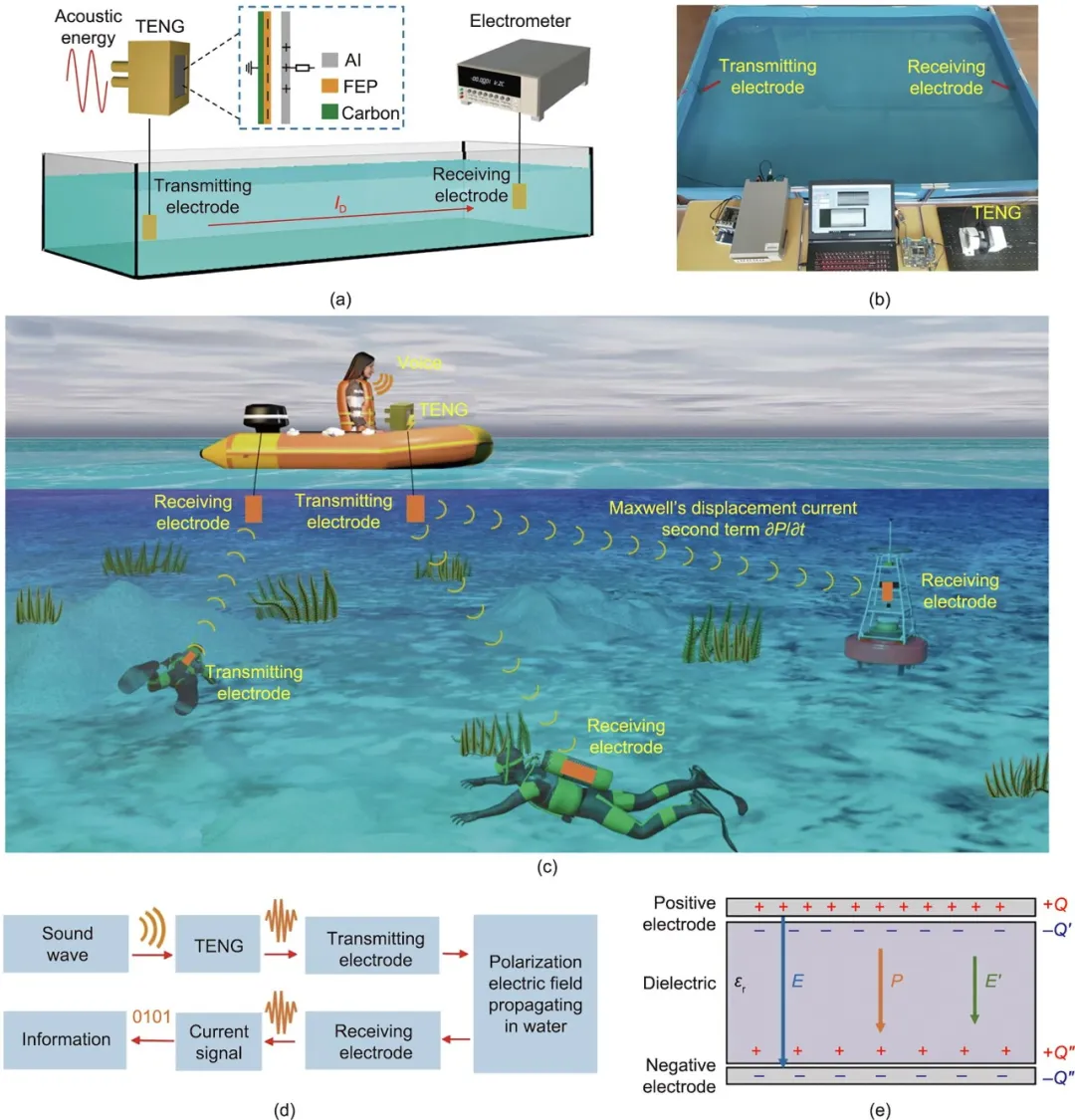
Figure 3. Underwater wireless communication generated through TENG’s Maxwell displacement current. (a) Schematic diagram of the experimental process and (b) photo; (c) schematic diagram of underwater electric field communication application based on TENG; (d) workflow diagram for underwater wireless communication; (e) schematic diagram of the capacitor model. εr: Relative permittivity; E: Original electric field; P: Polarization electric field; E’: Combined electric field of E and P; Q: Charge amount.
Although triboelectric nanogenerators have made significant progress in blue energy harvesting and marine environmental monitoring, continuous exploration is still needed in energy conversion, device durability, power management, and environmental applications. In the future, researchers will continue to focus on these issues to strive for the commercialization of large-scale blue energy harvesting and marine environmental monitoring applications.
This research provides important references for the further development of triboelectric nanogenerators in the field of blue energy harvesting and marine environmental monitoring, and is expected to promote the development and utilization of marine blue energy, contributing to the achievement of carbon neutrality goals.
Article Information:
Advances in Triboelectric Nanogenerators for Blue Energy Harvesting and Marine Environmental Monitoring
摩擦纳米发电机在蓝色能源收集和海洋环境监测方面的研究进展
Authors:
Jiang Yang, Liang Qian, Jiang Tao, Zhong Lin Wang
Citation:
Yang Jiang, Xi Liang, Tao Jiang, Zhong Lin Wang. Advances in Triboelectric Nanogenerators for Blue Energy Harvesting and Marine Environmental Monitoring[J]. Engineering, 2024, 33(2):204-225.
For submissions, reprints, or collaborations, please contact WeChat:MatResFron001
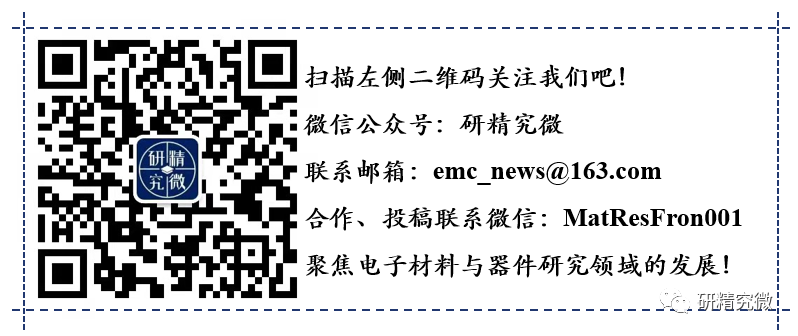
Welcome to leave a message and share your views.Support the authors by clicking the “Like” button in the lower right cornerand “Looking”↓↓↓